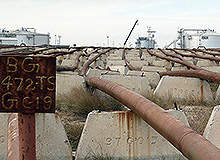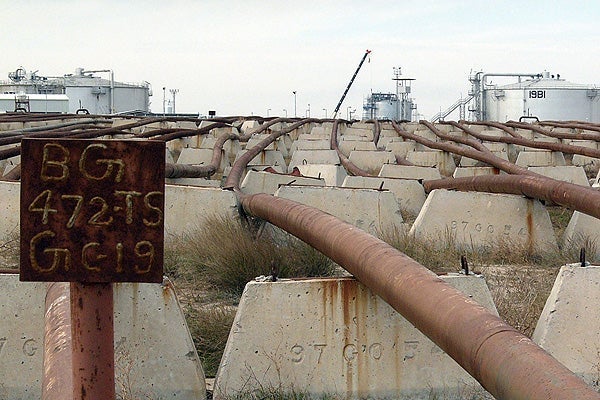

Eight of the top ten onshore oil fields are in the Middle East, while the other two are situated in the US and Venezuela. Hydrocarbons-technology.com lists the world’s ten biggest oil fields based on estimated recoverable oil reserves.

Discover B2B Marketing That Performs
Combine business intelligence and editorial excellence to reach engaged professionals across 36 leading media platforms.
Ghawar, Saudi Arabia
The Ghawar field in Saudi Arabia holds estimated remaining oil reserves of 70 billion barrels, making it by far the world’s biggest onshore oil field. The giant oil field was discovered in 1948 and has been in production since 1951.
The field, which measures 160mi in length and 16mi in width, is in the Al-Ahsa Governorate of Saudi Arabia and comprises six main producing areas namely Fazran, Ain Dar, Shedgum, Uthmaniyah, Haradh and Hawiyah.
Ghawar has produced more than 60 billion barrels of oil in the last 60 years of its operation and continues to produce approximately five million barrels of oil per day. The field is owned and operated by state-owned Saudi Aramco, the world’s biggest oil and gas company.
Spraberry/Wolfcamp, United States of America
The Spraberry/Wolfcamp field located in the Permian Basin of West Texas, USA, is the second biggest onshore oil field in the world. It is also the biggest oil field in the US, which is the world’s biggest oil consuming country.

US Tariffs are shifting - will you react or anticipate?
Don’t let policy changes catch you off guard. Stay proactive with real-time data and expert analysis.
By GlobalDataThe 150mi long and 75mi wide field was discovered in 1949 and contains approximately 50 billion barrels of recoverable oil resources. Pioneer Natural Resources owns and operates the field.
The 10 biggest oil consuming nations account for more than 58% of the world’s total oil consumption per day.
Oil and gas resources from the onshore field are produced at depths ranging from 6,000ft to 11,000ft from multiple formations namely the upper and lower Spraberry, the Jo Mill, the Dean, the Wolfcamp, the Atoka, the Strawn and the Mississippian.
Greater Burgan, Kuwait
The Greater Burgan oil field located in the desert of south-eastern Kuwait is the world’s third biggest oil field, containing more than 40 billion barrels of remaining recoverable oil reserve. The onshore oil field comprises three subfields namely Burgan, Magwa and Ahmadi, which cover a total surface area of approximately 1,000km2.
The field was discovered in 1938 and has been producing oil since 1946. It accounts for about half of the total oil production of Kuwait, the tenth biggest oil producing country in the world.
Greater Burgan is operated by Kuwait Oil Company (KOC), a subsidiary of state-run Kuwait Petroleum Corporation (KPC). The field currently produces between 1.1 and 1.3 million barrels of oil per day. KOC is planning to boost the field’s capacity to 1.7 million barrels a day by employing water injection recovery methods in the nearby Wara reservoir.
Carabobo 1, Venezuela
The world’s fourth biggest onshore oil field is the Carabobo 1 oil field located on the oil-rich Orinoco Belt in Venezuela. The field, containing 31 billion barrels of estimated recoverable oil reserves, commenced production at the beginning of 2013.
The field is operated by Petrocarabobo, a joint venture of Venezuela’s state-run energy monopoly PdVSA (60%) and five other stake holders including Spain’s Repsol (11%), Malaysia’s Petronas (11%), and India’s ONGC Videsh (11%), Indian Oil Corporation (3.5%) and Oil India (3.5%).
The field produces 30,000 barrels of crude oil per day in the first phase and aims to achieve an ultimate production level of 400,000 barrels of crude oil per day. Carabobo 2 and Carabobo 3 are the two other projects in the Carabobo block which are yet to commence production.
Khurais, Saudi Arabia
The Khurais oil field, located around 250km south-west of Dhahran and 300km north south-east of Riyadh, with estimated recoverable oil reserves of more than 25 billion barrels, is the world’s fifth biggest onshore oil field and the second biggest in Saudi Arabia, the country that holds the second biggest proven oil reserves after Venezuela.
The field comprises of three oil reservoirs namely Khurais, Abu Jifan, and Mazalij covering a total area of 2,890km2, and is operated by Saudi Aramco. Production from the field commenced in 2009 and currently stands at 1.2 million barrels of Arabian light crude oil a day.
Saudi Aramco awarded a front-end engineering design (FEED) contract to Foster Wheeler in October 2013 to expand the field’s production capacity to 1.5 million barrels a day by 2017.
Marun, Iran
The Marun oil field located in the Khuzestan province of Iran contains estimated recoverable oil reserves of 22 billion barrels making it the world’s sixth biggest onshore oil field. The field was discovered in 1963, and owned and operated by state-owned National Iranian Oil Company (NIOC).
The Marun field was brought on stream in 1966 and its production gradually raised to more than one million barrels of oil a day in 1972.
Marun is currently producing approximately 500,000 barrels of crude oil per day. It is the second biggest producing onshore oil field after Ahwaz.
West Qurna, Iraq
The West Qurna oil field located in southern Iraq, approximately 65km Basra, is the seventh biggest onshore oil field in the world. The field contains approximately 21.5 billion barrels of recoverable oil reserves.
The oil field was discovered in 1973 and consists of two separate licence areas namely West Qurna-1 and West Qurna-2. Although there has been some historical production from West Qurna-1, the West Qurna-2 remains largely underdeveloped.
A consortium of Exxon Mobil and Royal Dutch Shell was awarded the right to develop the West Qurna-1 field in November 2009. The $25bn West Qurna-2 project is being jointly developed by Russia’s Lukoil (75%) and the North Oil Company of Iraq (25%).
Ahwaz, Iran
The Ahwaz oil field, located in the Khuzestan Province of Iran, holds 18 billion barrels of recoverable oil reserves ranking as the eighth biggest onshore oil field in the world.
The onshore field, also known as Ahwaj-Asmari, comprises three production areas namely Asmari, Bangestan and Mansouri. Asmari is the biggest among the three production zones.
The Ahwaz field with an output of 750,000 barrels a day is the biggest producing onshore field in Iran, the country that possesses the fourth biggest oil reserves in the world.
Rumaila, Iraq
The Rumaila oil field is located onshore in southern Iraq, around 32km away from the Kuwait border, with 17.8 billion barrels of recoverable oil reserves, and is the world’s ninth biggest onshore oil field. The Rumaila field is being currently operated by a consortium of BP (38%), CNPC (37%) and the Iraq government’s representative State Oil Marketing Organisation (SOMO-25%).
The Rumaila field was discovered in 1953, with 65 billion barrels of initial oil in place. Approximately 20 billion barrels of oil was recovered from the field by 2009, while the production in 2009 was one million barrels of oil a day.
Iraq’s state-owned South Oil Company (SOC) awarded a technical service contract (TSC) to BP and the China National Petroleum Corporation (CNPC) in November 2009 to increase the field’s production to 2.85 million barrels a day by 2016.
Aghajari, Iran
The Aghajari oil field located in the Khuzestan Province of Iran, holding 17 billion barrels of recoverable oil reserves, is the world’s tenth biggest onshore oil field.
The Aghajari field, owned and operated by National Iranian Oil Company (NIOC), was discovered in 1938 and began production in 1940. The initial proven oil reserves at the field were estimated at 22 billion barrels.
The oil field was producing 172,000 barrels of oil per day as of 2005. A major gas injection project was implemented for the field in 2008 to raise the production level to 300,000 barrels a day.




